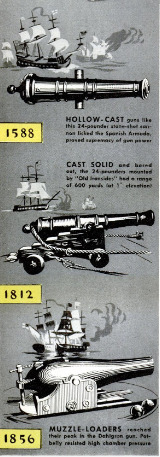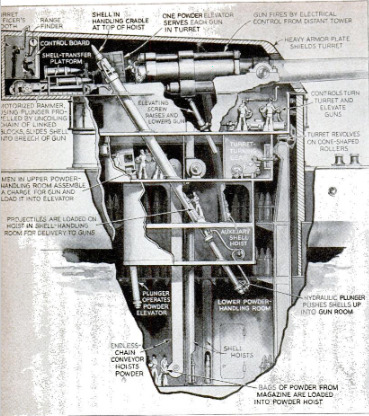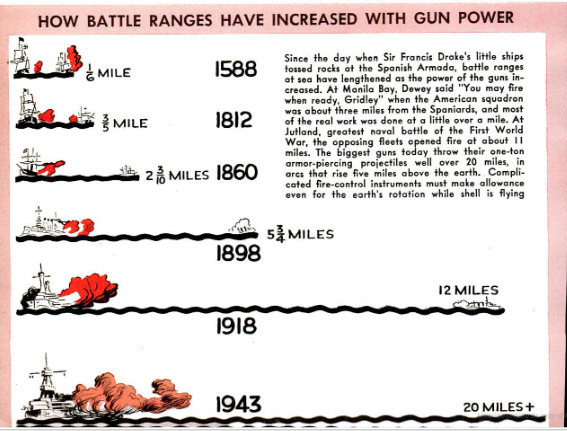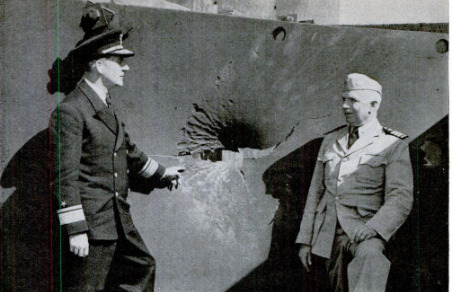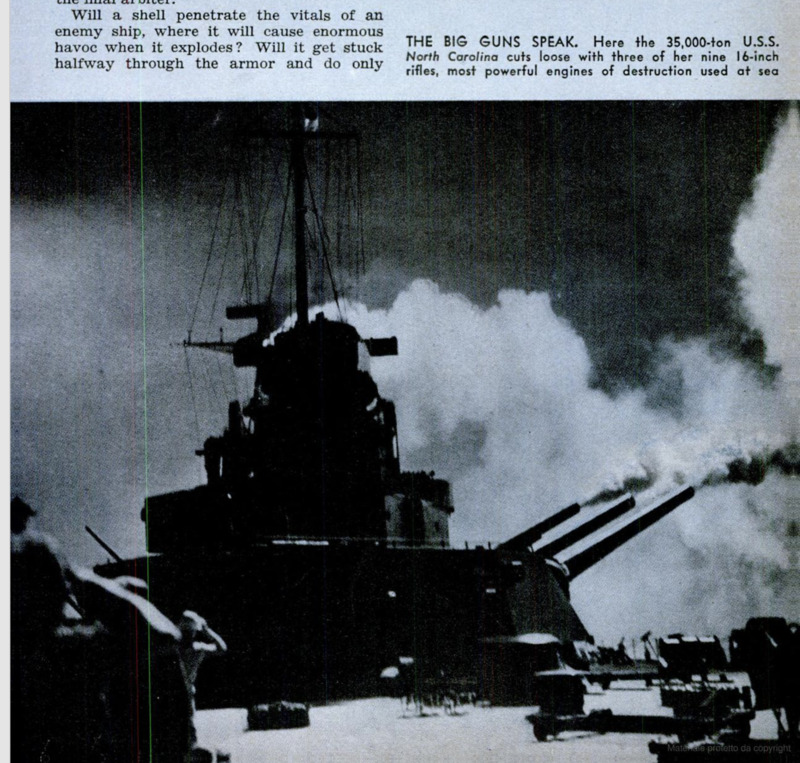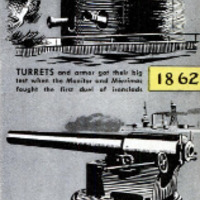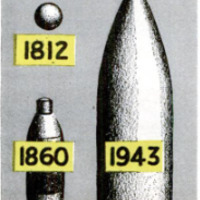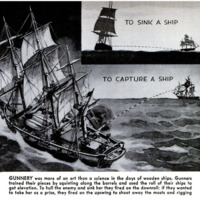-
Title (Dublin Core)
-
The Evolution of Naval Guns and Armor
-
Article Title and/or Image Caption (Dublin Core)
-
The Evolution of Naval Guns and Armor
-
extracted text (Extract Text)
-
RIVALRY between makers of warship
armor and of guns and projectiles to
smash it—a never-ending contest—reaches
a higher pitch today than ever before.
Thundering turrets of hostile men-of-war
are proving that no weapon has yet out-
moded naval artillery. Both in engage-
ments of limited scope, and in the Allies’
grand clash with Japan's main fleet that
some observers predict will once and for all
settle the control of the seven seas, the
clang of metal against metal may well be
the final arbiter.
Will a shell penetrate the vitals of an
enemy ship, where it will cause enormous
havoc when it explodes? Will it get stuck
halfway through the armor and do only
minor damage ? Or will it harmlessly glance
Off the ship's protective belts of steel? Ques-
tions like these preoccupy the U. S. Navy's
Bureau of Ordnance, just as similar prob-
lems confronted designers of the first can-
non used aboard ships in the year 1400 or
thereabouts. Highlights of developments
from that time to the present offer an il-
luminating glimpse of the evolution of naval
gunplay.
What we now call fire power first became
recognized as the decisive factor in war at
sea when the superior shooting of Sir Fran-
cis Drake’s English fleet defeated the Span-
ish Armada in 1588. Drake’s cannon were
crude weapons of brass or iron, cast hollow
on a core, but they packed the punch
that brought him victory.
About 1750, a Swiss mechanic in-
vented a boring machine, which made
it possible to cast a cannon solid and
then bore out its barrel with reasonable
precision. Guns made in this way were
more powerful and accurate than the
hollow-cast kind.
Dy the year 1sUo, when Lhe Driush
defeated the French and Spanish in the
celebrated naval battle of Trafalgar,
Nelson's victorious ships of the -line
mounted the best guns of their time.
These 32-pounders—so called from the
weight of the iron cannon balls they
fired—measured nearly 10 feet long
and weighed three tons. Their point-
blank range was 350 yards, the distance
at which decisive sea engagements then
were fought; and their extreme range,
a mile and a half. Probably their pene-
trating power compared with that of
the foot-longer 24-pounders carried by
the U. S. frigate Constitution in the
War of 1812—22 inches of oak at 1,000
yards. Including smaller weapons, Nel-
son's biggest ships were armed with
considerably more than 100 guns apiece.
But when about half of them fired a
broadside, they sent no more than 1,300
pounds of iron hurtling at the enemy—
less than two thirds the weight of a
single armor-piercing projectile from a
modern 16-inch gun.
A momentous advance in naval gun-
nery—the introduction of explosive
shells—came in 1822. Paixhans, a
French artillerist, designed an eight-
inch flat-trajectory cannon whose 62-
pound shell contained a bursting charge
of four pounds of black powder. Tests
proved that this projectile had a tre-
mendous incendiary effect upon a wood-
en ship. But conservatism in the French
Navy was so strong that the new weap-
on was not adopted until 1837. The
British hesitated two years more before
producing a similar shell gun, to be
used along with their time-tested 32-
pounders
For 15 years after the French and
British began arming their ships with
shell guns, neither did anything useful
about protecting their ships from these
weapons. After a few sketchy trials in
which guns shot holes through thin
cast-iron plate, it was decided offhand
that armor was no good.
Gunmakers made the most of their
temporary advantage. Muzzle-loading,
smoothbore cannon reached the peak
of their development in America, with
production, by 1856, of Dahlgren guns
for our Navy, ranging in bore from
nine to 11 inches and capable of firing
either shells or solid shot.
Advocates of armor now saw the
doom of warships lacking it. The
world’s first seagoing ironclad, La
Gloire, completed by the French in
1859, sheathed her wooden hull with
armor plate 41; inches thick. Britain
countered in 1861 with the Warrior,
an all-iron warship with the same
armor thickness. Across the Atlantic,
spurred by the Civil War, Federal and
Confederate forces were racing to
complete the first American ironclads
—the celebrated Monitor and Merri-
mac. It was almost a photo finish.
Hardly had the Confederate rebuilt
frigate begun sending wooden Federal
ships to the bottom before, on the
morning of March 9, 1862, the Fed-
eral warship Monitor arrived at
Hampton Roads, Va., and went into
action, It was the first time in history
that ironclad tangled with ironclad.
Neither ship won a decisive victory.
The Monitor's two 11-inch Dahlgren
guns—the same size as those on Ger-
many's “pocket battleships”—were
mounted on a revolving turret that
went out of order during the battle.
Nevertheless, the “cheesebox on a
raft” was able to outmaneuver the
unwieldy Merrimac and to present a
small target for her 10 guns, of which
the largest were nine-inch Dahlgrens.
The net result was that the Merri-
mac’s four-inch bars of armor and the
Monitor's five-inch side armor and
eight-inch turret armor were only
dented. At least, the legend of the
all-conquering Merrimac had been
buried at sea.
~The next move was up to the gun-
makers. Their answer was to substi-
tute rifled guns for those of smooth
bore. True, some of the Merrimac’s
smaller guns had been rifled, like
those of the British Warrior; but none
had received extensive trials.
Rifling consists of a helical-shaped
insert within a gun barrel, which
spins the projectile as it leaves the
gun. This steadies a shell in flight, so
that it keeps accurately headed for its
target instead of tumbling over and
over. But there was another advan-
tage of rifling that attracted early
designers.
Smoothbore guns wasted power.
Round shot had to fit so loosely, to
avert danger of explosion if it stuck
in the bore, that a quarter of the pro-
pelling gasses escaped around it. Ri-
fling permitted the use of
an elongated, tight-fitting
projectile.
However, many cast-iron
rifled guns burst, because the
charge required to start the
projectile on its way had to
be heavier to overcome the
10-percent retarding effect of
the rifling. The obvious reme-
dy was to build guns of steel,
with four times the tensile
strength of cast iron. Krupp,
German armament maker,
tried it as early as 1851. But
steel was expensive and hard
to get until, in 1857, Besse-
mer perfected his process of
making it cheaply and in
quantity. After that, rifled
guns improved rapidly.
Now guns and arms once
more were on even terms. In
1875. the British commis-
sioned the Devastation, considered the
world’s first modern warship. She was the
first large seagoing fighter to dispense with
sails. Her 25-ton muzzle-loading rifles were
mounted in turrets protected by 14 inches of
armor, and she had a 12-inch armor belt
along her water line. A little later the
French built a ship with 15 inches of armor.
Then, in 1881, the British launched the
thickest-armored ship ever built—the In-
wvincible, with a 24-inch-thick armor belt and
17 inches of armor over her turrets. Her
main battery numbered 16 81-ton muzzle-
loading rifles—the last muzzle-loaders that
were mounted on a first-class battleship.
The earlier smoothbore guns were pot-
bellied because it took a lot of cast iron to
withstand the chamber pressure set up by a
propelling charge of fast-burning black
powder. They were short-barreled, since
there wasn’t any use of having a long barrel
in which the pressure dropped 90 percent
after the cannon ball had traveled one foot;
on the rest of the way to the muzzle, it was
moving much faster than the gases which
should have been propelling it. About 1880,
slower-burning brown powder became avail-
able. Its large, perforated grains exploded
progressively and built up increasing gas
pressure behind the projectile. Use of this
powder reduced chamber pressures and
made long barrels pay dividends in aug-
mented muzzle velocity. Naval guns lost
their potbellies and began to assume their
present lean form.
Three years after the Invincible had been
launched, the British themselves canceled
her invincibility with next to the largest
naval gun ever built—a 16%-inch monster
which, at a range of 1,000 yards, could send
a 1,2800-pound projectile through 34 inches
of wrought iron. Those were dark days for
the armorers, whose problem seemed hope-
less—until nickel-steel plate, the first great
improvement in armor plate, was intro-
duced in Europe in 1889. In the same year
our Carnegie and Bethlehem plants were
producing it. The next year, they turned
out even more efficient armor, face-hard-
ened by the Harvey process.
The day of the heavily armored, big-gun
ship had dawned. After letting our fleet
rust from the Civil War to the mid-1880's,
Congress appropriated funds for the ships
that became world-famous as the White
Squadron. We bought guns from England,
brown powder and armor plate from Ger-
many, and armor-piercing shell from
France. Then the lawmakers wisely decreed
that only materials of American make
should be used in building our new Navy—
a move which led to the establishment of an
armament industry in the United States.
Once more the armor-makers suffered a
setback. Smokeless powder, a slower-burn-
ing and more powerful propellant than
brown powder, appeared in Europe and soon
was in production here. By about 1890,
American steel companies began forging
armor-piercing shells, and we soon were
making the high explosives that supplanted
powder as the bursting charge in them. Our
gunmakers produced 13-inch turret guns
for the battleship Oregon.
Our new guns and ships were tested at
Manila Bay and Santiago, and the United
States came out of the Spanish War a world
naval power. Ever since then, our guns and
armor have been at least as good as those of
any other nation.
In 1316 we mounted 16-inch guns on 11e
Maryland, and the Japanese brought out
their Mutsu class with 16-inch guns. The.
biggest British battleship guns used in
World War I were of 15-inch size. Two 18-
inch guns, the largest ever to go to sea,
were mounted by the British upon the
cruiser Furious. Soon, however, the ship
was converted into a carrier, and the guns.
went to Singapore as harbor-defense Weap-
ons. Presumably, the Japs have them now.
So far as is known, the biggest guns of
French, German, and Italian warships are
15-inch. Britain used 16-inch guns for the
first time in her Rodney class of 1925; went
back to 14-inch for the King George V class
in 1939; and returned to 16-inch for her new
Lion class.
All new American battleships, including
the 35,000-ton North Carolina class and the
45,000-ton Iowa class, employ main bat-
teries of 16-inch guns. Modern design makes
them the most powerful engines of destruc-
tion that have ever been used at sea. They
weigh 100 tons. Their one-ton armor-pierc-
ing projectiles travel a half mile a second.
Fired at an elevation of 42 degrees, they
have a range of well over 20 miles, and
crash down upon armored decks from a
five-mile-high arc.
Bigger guns would have more destructive
power, but would impose increased difficul-
ties in ammunition handling, and a slower
rate of fire. Unless we see sensational im-
provements in armor, 16-inch guns will
probably be the largest that will ever be
used aboard a battleship.
Guns of six smaller sizes now are being
built for our Navy—eight-inch for heavy
cruisers; six-inch for light cruisers; five-
inch dual-purpose guns for the all-five-inch-
gun cruisers of the Juneau class, for sec-
ondary and antiaircraft batteries of the
larger ships, and for our new destroyers;
three-inch for DE boats, merchant ships,
and various other craft; and 40-mm. Bofors.
type and 20-mm. Oerlikon-type automatic
antiaircraft guns for numerous classes of
ships. Fourteen-inch guns still are used—
and are highly effective—on many battle-
ships, and four-inch guns (some of them
adapted for antiaircratt fire) are on World
War I destroyers now in service, but guns
of these calibers are not being built now.
Our naval guns are of two kinds—built-
up and radial-expanded.
S18 FOeilice 4 wici WOC JavESH SUn8
used in the turrets of our battleships all are
of the built-up type. Most of them are built
of five layers of metal—liner, tube, jacket,
and hoops. Initial bore compression is ob-
tained by shrinkage; then the jacket and
hoops are heated and shrunk into place over
the tube. Bag ammunition is used in these
guns. First the projectile is loaded; then the
propelling charge, contained in one or more
silk bags, each with an ignition charge in
its base, is loaded behind it. The breech
mechanism is a rotating block with an in-
terrupted-screw plug which may be entered
or withdrawn in one motion and locked or
unlocked by a part turn. A safety device
prevents the firing of the gun until the
breech is closed. Combination primers are
used, but normally firing is by electricity.
In ships built since 1916, guns from eight-
inch to 16-inch caliber have been mounted
in three-gun turrets. A turret of a battle-
ship of the Jowa class weighs as much as a
destroyer. The turret is built in three parts
—foundation, barbette, and turret proper.
The turret foundation is a cylindrical struc-
ture of heavy girders and beams built into
the structure of the ship; it supports a cir-
cular track carrying rollers on which the
turret rotates. The barbette is a stationary
cylinder of heavy armor, which surrounds
the turret foundation from the ship's lowest
protective deck up to the armor skirt se-
cured to the turret. The turret proper is a
heavily armored, boxlike structure which
rotates, and in which the guns are mounted;
in it also are the power rammers with
which the guns are loaded.
Guns of eight-inch and smaller caliber are
built by the radial expansion process. Our
eight-inch and six-inch guns are composed
of a tube and a shrunk-on jacket which ex-
tends halfway from the breech to the muz-
zle. The eight-inch and many of the six-
inch guns are mounted in three-gun turrets,
have breech and firing mechanisms of the
same types as the larger turret guns, and
use bag ammunition.
Since 1898 all navies have used Krupp-
process armor, face-hardened to break up
projectiles, for water-line belts, barbettes,
and turret sides. It has been greatly im-
proved by American makers in recent years.
For horizontal protection our Navy uses
homogeneous plate, which tends to “dish”
without cracking when it is exposed to
oblique hits. Most modern battleships have
a protective deck six inches or
more thick over their vital parts,
and their turret tops are as
heavy. Our battleships general-
ly have been more heavily ar-
mored than any other navy's
ships of like size. The new ones
are protected by vertical armor
belts over one foot thick—how
much, Japan would like to know.
-
Contributor (Dublin Core)
-
Arthur Grahame (writer)
Frank Hubbard (drawings)
-
Language (Dublin Core)
-
eng
-
Date Issued (Dublin Core)
-
1943-12
-
pages (Bibliographic Ontology)
-
51-57
-
Rights (Dublin Core)
-
Public Domain (Google digitized)
-
Archived by (Dublin Core)
-
Matteo Ridolfi
-
Alberto Bordignon (Supervisor)
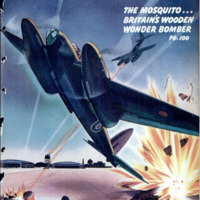 Popular Science Monthly, vol. 143, n. 6, 1943
Popular Science Monthly, vol. 143, n. 6, 1943

